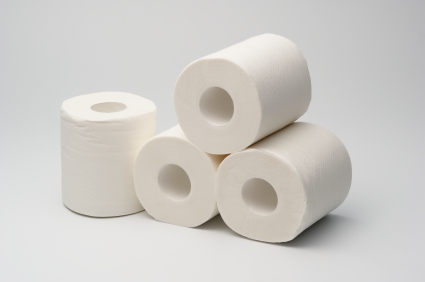
Think about the products you repeatedly buy at the grocery store — toilet paper is probably a major item on the list, right? You can’t seem to purchase enough of it even when you get it in bulk. Modern households consider this product a bathroom essential, but toilet paper is actually a rather new invention.
Before the late 19th century, people used
various materials such as corncobs, tundra moss, snow, wool, lace, coconut and mussel shells, sponges and mail-order catalogs. Thanks to the invention of paper on a roll, reclaimed paper can be turned into cushiony soft wipes.
Recycled paper to double-ply toilet paper
According to the
Toilet Paper Encyclopedia, each resident of the U.S. consumes approximately 730 pounds of toilet paper per year. In order to keep up with this incredibly high demand, some toilet paper companies choose to use recycled paper instead of virgin material.
First, the recycled paper is mixed with lukewarm water for about 10 minutes until it becomes pulp. Then it is strained through screens to remove plastic, paper clips and other non-fiber materials. During the de-inking stage, the liquid pulp is injected with air so that the ink adheres to the air bubbles. Next, the pulp is rolled and flattened to remove water, and it is then chopped up so it can be bleached with nontoxic chemicals. Now that the pulp is pure white, it can be spread out and dried within seconds by hot driers.
The dry pulp is rolled onto a large spool and is then
embossed by a metal roller that has a pattern. The imprint makes the paper thicker more absorbent. Large, quick machines spool and cut tubes of cardboard to prepare them for the two sheets of paper (2-ply) that will be wound around them. The end of the roll is sealed with glue, and a circular saw cuts the long cardboard tubes of toilet paper into 16 standard rolls (4 inches wide).
At this point, the toilet paper can be packaged. For commercial use, the toilet paper is individually wrapped, but for residential use, it’s packaged in transparent plastic.
Since machines do most of the work turning recycled paper into bathroom tissue, the process seems simple and quick. However, it’s still such an amazing transformation that has provided us with a convenient product that you might want to take a moment to appreciate it a little more.
 Think about the products you repeatedly buy at the grocery store — toilet paper is probably a major item on the list, right? You can’t seem to purchase enough of it even when you get it in bulk. Modern households consider this product a bathroom essential, but toilet paper is actually a rather new invention.
Before the late 19th century, people used various materials such as corncobs, tundra moss, snow, wool, lace, coconut and mussel shells, sponges and mail-order catalogs. Thanks to the invention of paper on a roll, reclaimed paper can be turned into cushiony soft wipes.
Think about the products you repeatedly buy at the grocery store — toilet paper is probably a major item on the list, right? You can’t seem to purchase enough of it even when you get it in bulk. Modern households consider this product a bathroom essential, but toilet paper is actually a rather new invention.
Before the late 19th century, people used various materials such as corncobs, tundra moss, snow, wool, lace, coconut and mussel shells, sponges and mail-order catalogs. Thanks to the invention of paper on a roll, reclaimed paper can be turned into cushiony soft wipes.
 Think about the products you repeatedly buy at the grocery store — toilet paper is probably a major item on the list, right? You can’t seem to purchase enough of it even when you get it in bulk. Modern households consider this product a bathroom essential, but toilet paper is actually a rather new invention.
Before the late 19th century, people used various materials such as corncobs, tundra moss, snow, wool, lace, coconut and mussel shells, sponges and mail-order catalogs. Thanks to the invention of paper on a roll, reclaimed paper can be turned into cushiony soft wipes.
Think about the products you repeatedly buy at the grocery store — toilet paper is probably a major item on the list, right? You can’t seem to purchase enough of it even when you get it in bulk. Modern households consider this product a bathroom essential, but toilet paper is actually a rather new invention.
Before the late 19th century, people used various materials such as corncobs, tundra moss, snow, wool, lace, coconut and mussel shells, sponges and mail-order catalogs. Thanks to the invention of paper on a roll, reclaimed paper can be turned into cushiony soft wipes.